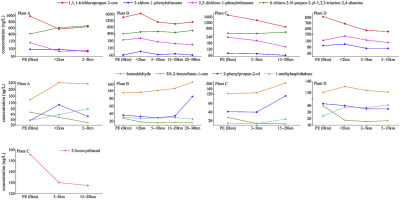Environmental Pollution ( IF 7.6 ) Pub Date : 2017-09-11 , DOI: 10.1016/j.envpol.2017.09.008 Chunmei Li , Donghong Wang , Xiong Xu , Meijia Xu , Zijian Wang

|
We investigated the occurrence of disinfection by-products (DBPs) with genotoxic potential in plant effluent and distribution water samples from four drinking water treatment plants in two Chinese cities using comprehensive two-dimensional gas chromatography–quadrupole mass spectrometry. We tested the samples for 37 DBPs with genotoxic potential, which we had previously identified and prioritized in water under controlled laboratory conditions. Thirty of these DBPs were found in the water samples at detection frequencies of between 10% and 100%, and at concentrations between 3.90 and 1.77 × 103 ng/L. Of the DBPs detected, the concentrations of 1,1,1-trichloropropan-2-one were highest, and ranged from 299 to 1.77 × 103 ng/L with an average of 796 ng/L. The concentrations of 6-chloro-2-N-propan-2-yl-1,3,5-triazine-2,4-diamine and 2,6-ditert-butylcyclohexa-2,5-diene-1,4-dione were also much higher, and ranged from 107 to 721 ng/L, and from 152 to 504 ng/L, respectively. Concentrations of 1,1,1-trichloropropan-2-one, 2-chloro-1-phenylethanone, 2,2-dichloro-1-phenylethanone and 6-chloro-2-N-propan-2-yl-1,3,5-triazine-2,4-diamine were highest at or near the treatment plants and decreased with increasing distance from the plants. Patterns in the concentrations of benzaldehyde, 2-phenylpropan-2-ol, and 1-methylnaphthalene differed between plants. The levels of DBPs such as 4-ethylbenzaldehyde, (E)-non-2-enal, and 1-phenylethanone were relatively constant within the distribution systems, even at the furthest sampling points (20 km < d < 30 km). A risk assessment showed that there was no risk to human health. It is, however, important to note that, because of limited availability of toxicity data, only five DBPs were evaluated in this study. The risks to health associated with exposure to the target potentially genotoxic DBPs should not be ignored because of their prolonged existence in drinking water.











































 京公网安备 11010802027423号
京公网安备 11010802027423号